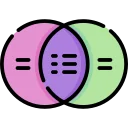Logical Menu
- Number Series
- Coding and Number Series
- Letter and Symbol Series
- Logical Sequence of Words
- Analogy and Classification Pattern
- Statements and Conclusions
- Statements and Assumptions
- Data Sufficiency
- Visual Reasoning
- Cube and Cuboid
- Cube
- Dice
- Directional Senses
- Blood Relations
- Odd Man Out
- Syllogism
- Arrangements
- Seating Arrangements
- Coding Deductive Logic
- Objective Reasoning
- Selection Decision Tables
- Attention to Details
- Inferred Meaning
- Cryprtarithmetic
- Get Off-campus Drive Updates
- Get Hiring Updates
- Contact US
PREPINSTA PRIME
Syllogism Questions and Answers
Syllogism Questions
Syllogism can be discussed as a kind of reasoning where an assumption is taken from two outlined or assumed offers. It is more of a logical reasoning instead of inductive reasoning. It is identified that most of the crucial sections of the exam includes syllogism in reasoning.

Rules for solving Syllogism Questions
One can face a lot of issues concerning the kind of sentence that may lead to the kind of conclusion. However, if you are thoroughly well aware of the rules mentioned below along with their correct use, then you are expected to commit no blunders while solving the questions. Check out the below rules:
–> Universal Positive Statement
To begin with universal signifies something that is appropriate to all as well as optimistic ways, such as the ‘yes’ kind of format. A universal positive statement specifies a little positivity relevant to all the things in that group. The positive category is signified by the alphabet ‘A’. These statements begin with All, Each and Every.
–> Universal Negative Statement
In this situation, the mere dissimilarity from the last type is that, in this situation, the sentence carries a negative meaning. It implies that it refers to that kind of sentence, which is common and giving a pessimistic expression. Such kinds of sentences start with No, Not a single, None of the, and more. These sentences are denoted by the letter ‘E’.
–> Particular Positive Statement
In this situation, the given sentence offers a positive expression, however, it includes only a few things and not all. These kinds of sentences often starts with some, a few, any, and are symbolized by the letter ‘I’.
–> Particular Negative Statement
Here, the statement again covers only some items, but it gives a negative impression. These kinds of sentences are symbolizes by the letter ‘O’.
- When there are two specific sentences, no universal assumption is imaginable.
- When there are two positive sentences, no negative assumption is imaginable.
- When there are two negative sentences, no positive assumption is imaginable.
- When there are two specific sentences, no assumption can take place, apart from when an ‘I’ kind of sentence is provided as well as by retreating it an ‘I’ kind of assumption can be done.
Important formulas to remember:
- Some + All= Some
- Some + Some= No Conclusion
- Some + No= Some Not
- No + No= No Conclusion
- No +All = Some Not Reversed
- No + Some = Some Not ( Reversed )
- Some Not/ Some Not Reversed + Anything= No Conclusion
- No + All = Some not Reversed
- All + Some = No Conclusion
- All + All= All
- All + No= No
Important Points
- Syllogism is comprised of three components, those are – minor premise, major premise and conclusion.
- The kind of syllogism which usually comprises these three elements is categorical syllogism. Although, two additional key types of syllogism are further present.
Prime Course Trailer
Related Banners
Get PrepInsta Prime & get Access to all 200+ courses offered by PrepInsta in One Subscription
Also Check Out
Syllogism Questions and Answers

Please login to report
Also Check Out
Get over 200+ course One Subscription
Courses like AI/ML, Cloud Computing, Ethical Hacking, C, C++, Java, Python, DSA (All Languages), Competitive Coding (All Languages), TCS, Infosys, Wipro, Amazon, DBMS, SQL and others
- Directional Senses – Questions | Formulas | How to Solve Quickly | Tricks & Shortcuts
- Blood Relations – Questions | Formulas | How to Solve Quickly | Tricks & Shortcuts
- Odd Man Out – Questions Formulas | How to Solve Quickly | Tricks & Shortcuts
- Directional Senses – Questions |
Formulas |
How to Solve Quickly |
Tricks & Shortcuts - Blood Relations – Questions |
Formulas |
How to Solve Quickly |
Tricks & Shortcuts - Odd Man Out – Questions
Formulas |
How to Solve Quickly |
Tricks & Shortcuts

 Apply For Jobs
Apply For Jobs Get Hiring Updates
Get Hiring Updates



